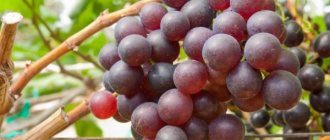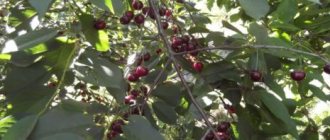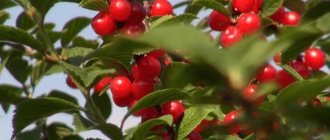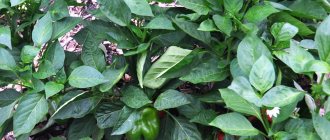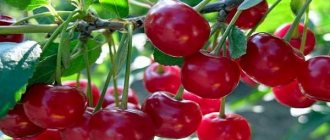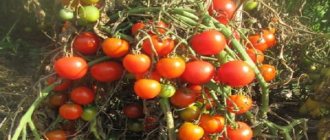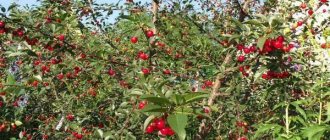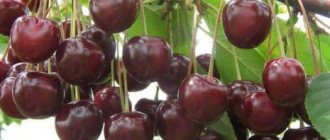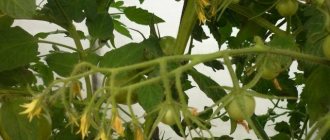History of variety development
The Brunette variety was bred by breeders from the All-Russian Selection and Technological Institute of Horticulture and Nursery Growing in the last quarter of the 20th century. To obtain a new variety, specialists freely pollinated the Zhukovskaya cherry, and seedlings were grown from the resulting seeds.
The resulting new cherry variety was sent for variety testing in 1995, and 6 years later this stone fruit tree was entered into the Russian State Register and given the name Brunette.
This variety is intended for cultivation in the Central region and other areas with similar climatic conditions.
Cherry Brunette - variety description, photos, reviews from gardeners
Registration for spring pruning has begun!
New entrance to the Nursery from spring 2021
Cherry variety Brunette
Description of the Brunette variety
Entry of the variety into fruiting, year
Detailed description of the Brunette variety of cherries: medium-sized, juicy, dark red fruits weighing up to 4 g, late ripening, with a very good taste, resistant to.
Features of planting and growing.
1. General information about cherries. Useful properties of cherries.
Cherry berries have been widely used in folk medicine since ancient times. Cherry is a dietary product; it increases appetite and improves the digestion process. Cherry fruits have a slight laxative effect.
Cherry has antiseptic and anti-inflammatory properties. Cherry juice quenches thirst at elevated temperatures. Traditional medicine recommends eating a kilogram of fresh cherries a day for a month, washing them down with 7-8 glasses of milk - this helps with arthritis and sclerosis. Cherry has a beneficial effect on the central nervous system; its decoction was used for mental illness and epilepsy.
The coloring pigment anthocyanin is highly digestible, as it is distributed throughout the fruit pulp. There is a lot of cherry fruit and coumarin, a substance that reduces blood clotting. This feature of cherries allows it to be used to prevent a number of complications of arterial atherosclerosis, and the successful combination of vitamins C, B1, B6, iron, magnesium, cobalt, and pigments in cherries is used to prevent and treat anemia.
Cherry - contains hematopoietic microelements: iron, copper, cobalt, which makes it possible to use it for anemia. Pectin substances help remove nitrogenous waste from the body. Cherry pulp contains bactericidal substances. Cherry juice is used for mental illness, arthritis, as a mild laxative, expectorant, thirst quencher and appetite enhancer. Cherries contain ellagic acid, which prevents the development of malignant tumors by blocking the growth of cancer cells. And the presence of anthocyanidins in berries helps reduce uric acid levels in the body. In addition, regular inclusion of cherries in the diet greatly reduces the risk of gout.
Ascorbic acid in combination with P-vitamin active tannins and cherry pigments tone, strengthen blood capillaries, reduce high blood pressure, and increase the body's resistance to adverse effects, in particular, to increased background radiation. Eating cherries reduces the frequency and severity of heart attacks.
2. Choosing a place for cherries.
— Cherry requires a well-lit place. Otherwise, a decrease in the sugar content of the fruit and a general decrease in yield are possible.
— Cherry is far from the most frost-resistant crop. In this regard, it is recommended to plant next to country houses (between a barn and a bathhouse, a house and a fence). The best place for cherries is sunny, closed on the north side by a brick wall, which, when heated, will not only protect from cold winds, but also damage the tree.
— Cherry does not tolerate stagnant water. If there is a possibility of flooding on the site, the tree should be drained if possible or planted on a hill. Otherwise, the tree will have poor development or even death. The groundwater level should be at least 1.5-2 m.
— Cherry grows best on light sandy or loamy soils. On heavy clay or sandy soil, cherries most likely will not develop. In this case, a good landing hole is required. The acidity of the soil should be close to neutral: pH 6.5-7.0.
3. Cherry planting and care.
— Planting of seedlings can be carried out exclusively in spring (for bare root plants), and from spring to September (for containerized plants).
— Cherry seedlings should not be buried when planted in the ground. The root collar (the place where the root enters the trunk) should be 5-7 cm above ground level.
— When buying a seedling in the spring, you can immediately prune the branches. You can't cut the roots. The more of them a young tree has, the faster it will take root. The roots can only be straightened.
— Almost all varieties of cherries growing in the Moscow region are considered self-sterile, that is, they need pollen from another plant to set fruit. Accordingly, you should keep this in mind and if you or your neighboring plot does not have another tree (another variety of cherry), you should purchase it immediately. Even in self-fertile varieties, yields increase significantly when a pollinator appears. There is also an opinion that although cherries and cherries practically do not cross-pollinate, they have a beneficial effect on each other.
— The feeding area of one cherry tree depends on the rootstock: for vigorous rootstocks - 12 sq.m., for medium-growing rootstocks 9 sq.m.
— When planting cherries, either organic fertilizer (horse humus or humus), potassium chloride - 20 g, superphosphate 30-40 g are placed in the planting hole.
Further feeding. Application of mineral fertilizers before flowering: urea (10 g), potassium chloride (15 g), superphosphate (25 g) per 10 liters of water.
Fertilizers are applied based on 1 sq.m of fertilized tree area. Ammonium nitrate (15-20 g), superphosphate (30-40 g), potassium (10-12 g).
Almost all types of soil under cherry trees require liming. Lime is applied once every 5-6 years in the form of dolomite flour, ground limestone, etc. The application rate depends on the type of soil and ranges from 300 to 500 g. The minimum dose is applied on light soils, and the maximum on heavy soils.
Autumn fertilizing should be WITHOUT nitrogen content. On rich lands, fertilizing should not be done often, but on poor, sandy soils, fertilizers must be applied annually.
— In the first year after planting, it is recommended to cut off 80-100% of the flowers. This is necessary for better survival of the tree. In the future, it is necessary to pick off half of the crop at the greenfly stage - only the established fruit, several centimeters in diameter. This operation is called crop rationing. Thanks to it, the fruits remaining on the tree when ripening will be larger, sweeter, and the tree will be better prepared for winter. In addition, in this way it is possible to at least partially overcome the periodicity - fruiting of a tree every other year.
— Watering cherries should be carried out 4-5 times a month at the rate of one bucket of water per adult tree, twice a day (morning and evening). Good watering is very important in the period June-July, when fruiting occurs, and at the same time flower buds are laid on the tree, forming the next year's harvest. If there is a lack of moisture during this period, crop losses are possible both in the current and next year. Watering should be completed in August; otherwise, protracted growth of shoots may result, which can negatively affect the winter hardiness of the tree. However, in a dry year, it is necessary to continue watering so that the tree is saturated with moisture. The watering regime should be adjusted depending on the weather. On soils with high groundwater levels, it is necessary to carefully approach the issue of watering, since cherries do not tolerate flooding.
Description
This cherry variety has an average height of about 2.5 m, although some of the trees can grow up to 3 m.
The spherical crown is quite spreading, but not thickened. Side shoots are formed in medium numbers, they are medium leafy. The leaf blades are elongated, with sharp tips, of medium size, with small denticles along the edges. The foliage color is dark emerald.
The inflorescences are umbrella-shaped, the flowers are white in color, with a pleasant strong smell.
The shape of the berries is round. The skin is slightly compacted, dark burgundy in color. The pulp is bright red and tender. The stone is small in size and easily separated from the pulp of ripe cherries.
The taste of ripe berries is pleasant; even gourmets will like the sweet and slightly sour fruits.
The average weight of the berries is about 4 g. They begin to ripen in mid-July, but the main harvest is harvested in the last ten days of July.
The fruits are tightly attached to the stalk, so they are not prone to falling off after ripening, but are easily separated from the stalks when harvested.
Ripe cherries can be transported over any distance; the berries do not burst or flow during transportation. The harvested crop should be processed within a few days after harvesting.
Description of the Turgenevka cherry variety
Turgenevka is a frost-resistant variety of domestic selection
Turgenevka is a medium-ripening cherry, which was bred on the basis of Zhukovskaya seedlings obtained by free pollination. In 1979, the variety was entered into the state register after testing and recommended for the Central Black Earth, North Caucasus and Central regions.
Important! This cherry variety is often popularly known as Turgenevskaya.
The characteristic features of the variety are as follows:
- Cherry belongs to the tree type, reaches a height of 3–3.5 m. The plant has a pyramidal, raised crown of medium density.
- The shoots are colored brownish-brown. The buds are cone-shaped, strongly deviated from the branches. The trunk is covered with bluish-brown bark.
- The leaves are dark green, oval with a sharp base, pointed apex and jagged edges, folded in a boat shape. They also have a glossy surface. There are 2–4 glands at the base of the plates and on the petioles.
- The inflorescences consist of four flowers with white adjacent petals. The corolla is unfolded. The calyx has the shape of a glass, the sepals are serrated. The flowering period begins in the second decade of May.
- The berries are large, reach a weight of 4–5 g, and have a round, wide-core shape. The funnel is medium. The skin is burgundy. The taste is sour-sweet. According to the tasting scale, the fruits are rated 3.7 points out of 5. The pulp is juicy with a dense structure, dark red in color.
- The stalks are medium in size, the cherries are semi-dry. The seed takes up 8% of the weight of the berry. It has an oval shape and cream color. It separates well from the pulp. The fruits are formed on bouquet branches.
Turgenevka is characterized by high winter hardiness. However, this property does not apply to generative buds. Their level of resistance to low temperatures is rated as average. The variety also does not tolerate drought well.
Important! If frost occurs after bud formation, there is a possibility of reduced or lost yield.
Key advantages and disadvantages
The Turgenevka variety gives a generous harvest of cherries for lovers of sweet and sour berries
From the description of the Turgenevskaya cherry variety it follows that it has many obvious advantages, but it also has disadvantages.
Main characteristics of the variety
The variety's resistance to cold is average. Flower buds may freeze during severe spring cold snaps.
Productivity
The first harvest from the Brunette cherry is harvested 3-4 seasons after planting the seedling in a permanent place. Up to 12 kg of ripe large fruits are collected from each tree. And when growing this variety on an industrial scale, up to 9 tons of berries can be harvested from each hectare.
The yield of Brunette cherries directly depends on compliance with the rules of care and on weather conditions in the growing region.
Pollinator trees
The Brunette cherry variety is self-pollinating, so for good yield this tree does not require the presence of other pollinating trees nearby. However, experienced gardeners note that if other cherry varieties with similar flowering periods grow nearby, the yield increases sharply.
The following cherry varieties can be taken as pollinator trees:
- Vladimirskaya;
- In memory of Enikeev.
Cherry “Youth”: description and care tips
Cherry is a heat-loving fruit tree, but gradually specially bred cold-resistant varieties are being developed in areas north of the middle zone, in the Urals, and southern Siberia.
We have 2 black morel trees - very large and tasty. I really like this variety.
- One of the most reputable early-ripening cherry varieties. The tree is vigorous, has a pyramidal crown at a young age, after several harvests the crown becomes spreading. The fruits are large (7-9 g), and in the south with watering - 12-15 g. The drupes are round-heart-shaped, dark red, almost black in color, there is a gray dot at the top of the fruit, and a mound in the groove. The juice and pulp of the fruits are colored intense red, the fruits are very tasty. The variety is resistant to pests and diseases, but has low winter hardiness of flower buds.
- Felt cherry
- Youth
- Particularly popular among many gardeners are self-fertile cherry varieties, as well as partially self-fertile ones - Shokoladnitsa, Zarya, Volochaevka, Yuno, Brunette, Truzhenitsa Tataria, Dessertnaya Volzhskaya, etc. They produce a consistently large harvest without special pollinator varieties that are used for pollination and fruiting of self-sterile cherries - Gnome, Fidelity, Griot of Moscow, Elegy. Fertile, Beauty of Tataria, Muse, etc. The difference in yield between these varieties is very significant. Thus, self-fertile cherries form about 20 - 40% of the fruits of the total amount of color, for partially self-fertile cherries the number of fruits is 5 - 19%, and for self-fertile ones it does not exceed 5%.
- A resistant variety popular in Siberia is the common Ashinskaya cherry. This is a self-fertile species, that is, grown without pollinators, but in very harsh winters its fruit buds may freeze. Therefore, Ashinskaya’s yield is not always stable over the years.
Cherry “Youth”
Many experienced gardeners know that you cannot plant the first tree you come across on your plot. After all, it is unknown how a particular species will feel in a given region. Therefore, only by choosing the right cherry varieties for their garden, plot owners have the opportunity to harvest a good harvest all summer and pamper their loved ones with delicious fruits rich in natural vitamins.
Read more: Plum La Crescent variety description
feeding should be regularResistance to dangerous fungal diseases (coccomycosis and moniliosis) averagepartially self-fertile (Turgenevka, Sania, Bagryanaya, Shchedraya).
Diseases and pests
With proper care, the resistance of this fruit tree to major diseases is quite high. However, if gardeners do not take care of the cherry, violate the watering regime or other care rules, the tree may be affected by some of the fungal or bacterial diseases:
- anthracnose;
- gum flow;
- perforated spotting.
In addition, the following pests can damage this cherry:
- cherry aphid;
- cherry weevil;
- slimy sawfly;
- shoot moth caterpillars.
Features of care
Cherry Brunette is unpretentious and quickly adapts to any conditions. But to increase productivity, it is necessary to follow the rules of care.
Trimming and shaping
Cherry formation includes several points:
- pruning side branches;
- thinning foliage;
- removal of damaged, dry and excess branches;
- rejuvenation of culture.
From the central trunk of the cherry tree there are many side branches that grow in three tiers. They begin pruning after their length reaches 50 cm. Pruning begins with branches that are below 40 cm from the ground.
Watering
Since the Brunette cherry continues to develop without a sufficient amount of moisture, watering is carried out only a few times during the entire growing season: during flowering, the formation of ovaries, after the leaves fall.
A month before the expected harvest, watering is stopped, even if the weather is dry. Excessive soil moisture leads to cracking of the berries and their rotting.
Fertilizers
If fertilizers were applied to the soil during planting, the supply of nutritional components will be enough for 2-3 years. After two years, fertilization is carried out according to the following scheme:
- fertilizing is necessary after the flowering period;
- Repeated application of fertilizers is carried out after two weeks.
Fertilizers must contain potassium, phosphorus and nitrogen. Immediately after feeding, the cherry tree trunk area is watered with water. This promotes better distribution of nutritional components.
Pests and diseases
Brunette cherry variety is damaged by the following pests:
- cherry aphids feed on the sap of the plant, which leads to drying out of the crown;
- adult weevils and larvae damage buds, ovaries, flowers, seeds, resulting in a decrease in yield;
- sawfly larvae eat the leaves, the plant develops slowly or stops growing completely;
- Moth caterpillars feed on buds, leaves, buds and ovaries.
Most often, cherries are infected with diseases such as:
- Clusterosporiosis develops as a result of excess moisture and heat; brown spots appear on leaves and fruits, which then turn into holes;
- the fungal disease anthracnose at high humidity affects the fruit seeds, the berries themselves become covered with tubercles with a brown coating;
- A bacterial burn leads to damage to the branches and bark, they turn black and dry out, and the buds do not open.
When a problem is discovered, they immediately begin to fix it. Otherwise, not only will the yield decrease, but the entire tree will die.
Advantages
The main advantages of the Brunette cherry variety include:
- good resistance to frost;
- resistance to periods of drought;
- good yield;
- Harvesting can be done by the end of July;
- ripe fruits are tightly attached to the stalks and are not prone to shedding or cracking.
But the variety also has a number of disadvantages that should be remembered:
- flower buds can be damaged at low temperatures, especially during returning spring frosts;
- Brunette cherry is characterized by low resistance to fungal diseases.
Features of planting and caring for the Shalunya cherry
Cherry is extremely popular among gardeners and lovers of stone fruits, because its fruits are distinguished not only by their pleasant sweet and sour taste, but also by their valuable biochemical composition. That is why scientists do not stop developing new varieties of it, one of which is the fruit of Ukrainian authors - the productive and unpretentious Minx with delicious berries, which will be discussed in the article.
History of variety selection
The Shalunya variety was obtained on the basis of the Melitopol Institute of Irrigated Horticulture named after. M. F. Sidorenko (formerly of the Melitopol Experimental Station IS NAAS). Work on variety selection was carried out in the mid-60s. last century by eminent Ukrainian scientists - Doctor of Agricultural Sciences Nikolai Turovtsev and his wife Valentina Turovtseva. The parent varieties of Shalunya were Samsonovka cherry and Duke (a hybrid of cherry and sweet cherry) variety Kyiv-19.
The first was chosen for its unpretentiousness and frost resistance, and the second for its unusually tasty berries.
The gradual crossing of these varieties over time gave an interesting hybrid, characterized by a good yield of large, juicy fruits. Afterwards, it very quickly spread across numerous horticultural farms in Ukraine. In 1997, Shalunya officially entered the State Register of the Russian Federation and was recommended for breeding in the North Caucasus region.
Description and characteristics of the variety
Let's look at the main characteristics of Shalunya, which distinguish it from all other cherry varieties.
Trees
The tree of this variety is fast-growing, medium-sized, with the height of an adult cherry up to 4 m. It is distinguished by a spreading, round, medium-dense crown with straight brown-brown branches of medium thickness. Cherry bark is flaky, gray-brown in color. The entire trunk is dotted with dark lentils - small tubercles of various shapes.
The leaves of Shalunia are medium sized, obovate. They have a smooth, bright green texture and a slightly pointed, curled shape. The short stipules are significantly dissected. The leaf petioles are thick, short, and pigmented. The fruits are formed on bouquet branches and annual growth, which should be taken into account when pruning trees.
Fetus
They are one-dimensional berries, quite large (5–6 g), flat-round, dark burgundy in color. Slightly overripe cherries take on an almost black tint. There is an inconspicuous ventral seam on the surface of the berry, and a slight depression at the base.
The skin of the cherry is shiny, thin, quite dense, with slightly pronounced spots, and can be easily removed. The pulp is juicy, soft, tender and has a burgundy tint. There is a small bone inside that can be easily removed. The taste of the Shalunia fruit is pleasant, sweet and sour, fresh. Experts rate their taste at 4.8 points.
How is the variety pollinated?
The variety belongs to a common type of self-sterile trees, the pollination of which requires closely spaced (up to 40 m) pollinating trees.
The best way to deal with this is:
- Samsonovka cherry;
- Chernokorka cherry;
- cherry Valery Chkalov;
- Vinka cherry.
Planting and caring for the Shalunya variety
Its vitality and the quality of the future harvest depend on the correct planting and further care of the tree.
Planting dates and choosing a suitable location
Cherry loves sunlight very much and is afraid of strong cold winds, which should be taken into account when choosing a planting site. A good location for the tree would be the southern part of the site, protected by a fence or some kind of building. However, the chosen place should not be in the shade for a long time. Minx prefers fertile, sandy loam, light loamy or soddy-podzolic soils.
In this case, the soil should easily allow water and oxygen to pass through, and groundwater should not come close to the surface (no closer than 1.5 m). In regions that experience cold winters, cherries should be planted in the spring before flowering begins. In the southern regions, autumn planting of the variety is allowed, but no later than the end of September.
Selection and preparation of planting material
For planting, you need to choose a 1-2 year old seedling with an open and well-developed root. The seedling should have a central conductor and 3–5 second-order branches. The bark of the tree should be healthy, smooth, brown-brown with gray lentils. The best place to purchase seedlings is a large, trusted nursery, where they guarantee varietal compliance and quality of the material.
When purchasing, pay attention to the integrity and uniformity of the bark and the freshness of the roots. In addition, when purchasing, you can get full advice on its cultivation. Also, when purchasing, you should pay attention to the height of the tree. One-year-old Shalunya has a height of about 70 cm, and two-year-old - from 1 m.
Landing technology
Planting a cherry seedling is done as follows:
- No later than 30 days before planting, choose a place and dig a hole with a diameter of about 60 cm and a depth of about 50 cm.
- The soil at the bottom of the pit is loosened and mixed with compost. A soil mixture is prepared from soil, compost, 30–40 g of superphosphate, 20–25 g of potassium chloride and up to 1 kg of wood ash. Coarse sand is added to heavy clay soil.
- The seedling is carefully inspected, all dried and damaged roots are removed. The central trunk is cut to the first branch, and the skeletal branches are shortened by 2/3 of the length. All cuts are treated with garden varnish.
- The rhizome is placed in a bucket of water for 6–12 hours, where a growth stimulator is added if desired.
- A peg is driven into the hole to support the seedling. A small earthen mound is arranged at the bottom, on which the tree is placed, and the roots are carefully straightened.
- The soil mixture is poured into the hole and compacted periodically. The planting depth is determined by the root collar of the tree, which should be above the ground at a height of 5–7 cm.
- An earthen roller is formed around the planted tree, and 2-3 buckets of settled water are poured into the formed hole.
- The seedling is tied to a peg with a figure-of-eight loop, and the settled soil is sprinkled with dry soil to the desired level.
- The root circle is mulched with a 3–5 cm layer of humus, peat or sawdust.
Video: instructions for planting cherries
Trimming and shaping the tree crown
Pruning is an annual event that:
- prevents thickening of the crown, the development of diseases and the spread of pests;
- allows you to avoid overspending of nutrients on unnecessary and damaged branches;
- increases the quantity and improves the quality of berries;
- prolongs the fertile period of Minx’s life.
The first pruning of the seedling is done during planting. Shoots should be trimmed in early spring before flowering begins. It is better to form an open crown in the shape of a glass. In this case, the central conductor is shortened above the upper side shoot, 4-5 strong branches are left at a height of about 1 m above the ground, and the rest are cut to 2/3 of the length. Over the next couple of years, the overgrown side branches are trimmed to 1/2 the length.
1. First post-planting pruning: a) tree before pruning; b) tree after pruning. 2. Reaction of a newly planted cherry tree to pruning after the beginning of the growing season
Fruit-bearing trees are pruned after harvesting:
- fruit-bearing shoots are shortened by 1/4 of the length;
- damaged, weak and growing branches growing inside the crown are removed;
- As the tree ages, individual 4-year-old shoots are pruned to renew the tree.
Pruning is carried out with a clean, sharpened tool; for branches thinner than 2 cm, a pruning shear is used. In this case, the cut should be made above the bud growing outward.
Video: spring pruning of cherries
Fertilizers and watering
Cherries will give a good harvest only if there is sufficient and timely watering. Good watering is especially important during flowering and ovary development. The amount of water for Minx depends on soil moisture and ambient temperature. During a particularly dry period, this may require 5–7 buckets of water. Full watering should moisten the soil to a depth of 40–50 cm. To ensure uniform watering, furrows 20–30 cm deep are made around the cherry tree along the crown border. Near the trunk, you can create another shallow furrow - up to 10 cm.
Fertilizing is also a mandatory agrotechnical measure when growing cherries. As a fertilizer, potassium chloride (15 g per 1 m²) is applied to the soil surface along the projection of the tree crown approximately in the middle of winter. Thus, by the beginning of the growing season, the chlorine will evaporate, and valuable potassium will nourish the soil. In the spring, before flowering begins, the soil around Shalunya is fertilized with rotted manure or compost. Ammonium sulfate is also added (30 g per 1 m²). Every 3 years, superphosphate (90 g per 1 m²) should be added along with ammonium sulfate.
Video: feeding a fruit tree
Preparing the plant for winter
Minx tolerates winter well provided it is planted in the areas for which it is intended, so preparation for winter consists only of watering and pruning the tree, as well as loosening and digging around the trunk. Young trees should be protected from rodents that actively eat the bark in the winter. To do this, you need to provide a circular installation of a fine mesh, tying the trunk with straw or spruce branches. You can also scare away mice by hanging elderberry or wild rosemary on the lower branches and trunk.
Diseases and pests
Minx is characterized by good immunity to diseases of stone fruit crops, including the most dangerous diseases - moniliosis and coccomycosis.
However, it is necessary to take preventive measures:
- Thin out the crown in a timely manner, trim off affected shoots, and remove fallen leaves and berries.
- Pruning should be done in dry weather to avoid spreading infection and pests.
- Water in a timely manner, loosen the tree trunk, remove weeds.
- Treat trees with 1% Bordeaux mixture - before buds appear, after flowering and after another 2 weeks.
- After flowering, hang Velcro bait against cherry flies near the planting.
- Digging up the soil in late autumn will destroy pests that have left for the winter.
- Treatment with insecticides according to the instructions for the preparations will help destroy aphids and other insects.
Tips for Beginner Gardeners
Beginner gardeners should remember that they should not be afraid to make mistakes: in most cases, any mistakes can be corrected. First you need to decide on a work plan and stock up on the necessary planting material and tools. Next, you need to strictly follow all recommendations for selecting, planting and caring for seedlings. At the same time, be sure to take into account the purpose of the variety and not plant Minx in the northern regions.
It is important to take note of the main points:
- buy seedlings from trusted producers;
- plant them in a sunny place with light, fertile soil;
- during cold winters, choose spring planting;
- do not forget about the need for pollinating trees;
- regularly water and feed the trees;
- Prune cherries annually and take preventive measures against diseases and pests.
Thus, with good care of the tree, Shalunya will delight you with fresh berries for many years and will be an excellent vitamin addition to any table.
Landing
Planting cherries in different regions of Russia should be done at different times:
- in the south of the country - in the fall, approximately 25-30 days before the onset of cold weather;
- in the Moscow region and other regions with similar climatic conditions - in the first ten days of September (but not later);
- in colder areas, seedlings of this cherry are planted only in the spring, since when planted in autumn, the trees may freeze in winter.
How to choose a place
It is better to choose a planting site on a small slope on the south side so that the trees are illuminated by sunlight throughout the day.
Brunette cherry grows well on loose loamy or sandy loam soils with neutral acidity. Moisture should not stagnate in the soil, so these trees should not be planted in lowlands or swampy areas. It is also impossible for groundwater not to approach the surface of the earth closer than 2 m.
If the soil in the area is highly acidified, then it is necessary to add dolomite flour or lime.
Sand and black soil are added to heavy soil to loosen it, and clay and humus can be added to sandy soil to improve it.
The pits for planting cherries are prepared in about a couple of weeks. Its depth should be at least 0.4 m, and its diameter should be at least 0.6 m. When preparing the hole, you need to take into account the size of the roots of the seedling.
A layer of drainage 5-7 cm thick is laid at the bottom of the hole, then a layer of garden soil mixed with fertilizers. A peg is driven into the hole to which the seedling will be tied.
The following fertilizers are placed in the pit: humus or compost, potash and phosphorus fertilizers.
Planting cherries
A seedling is placed in the center of the prepared hole, the roots are carefully straightened and covered with soil. In this case, the root neck of the tree should be 5-7 cm above ground level. The soil around is compacted, the seedling is tied to a peg, and then watered. At least 10 liters of water should be added to each tree.
Description of fruits
The berries of this variety are quite large. Average weight is 4-5 g. The diameter of the cherry reaches 16-17 mm. The fruits have a dark, rich color, the flesh is slightly lighter. The berry is juicy with a subtle sourness. The skin is quite dense, but is not felt when chewing.
Sverdlovchanka cherry fruits have a juicy taste with a subtle sourness
Application
The fruits of self-fertile Sverdlovchanka cherries are distinguished by high taste. They are used to prepare:
- jams, preserves, syrups;
- compotes, juices;
- jelly and other confectionery products;
- dried fruits
It is useful to eat berries fresh. One cup of cherries contains the daily requirement of iron and vitamin C. Regular consumption normalizes the level of hemoglobin in the blood.
For planting, it is recommended to buy seedlings at the age of 2 years with an open root system. They have a greater chance of being accepted and growing within 2-3 months. Planting is done in the spring, at the end of March or beginning of April, depending on weather conditions. Planting occurs in 3 stages:
- Preparing the planting hole. The width is at least 40 cm. Rotted horse or cow manure, 1/3 of a bucket of fine river sand and the top fertile layer of soil are placed at the bottom of the pit. All this is carefully mixed and 40 liters of water are poured in.
- If a plant with an open root system is treated with wax, it must be removed. It protected the roots from moisture evaporation and drying out, but it is not needed when planting. The roots are soaked in warm water.
- After planting, be sure to dig in a peg. It will hold the young plant and protect it from kinks in strong winds.
Sverdlovchanka is the standard cherry variety for the Urals. Due to the cold spring weather, planting can be postponed to the beginning of May; by this time the danger of return frosts will have passed, and you don’t have to worry about the branches freezing.
If the soil is too dry, the tree may drop its flowers and there will be no harvest. The best time for the next watering is when the ovaries begin to form. The tree must be watered during the period when the harvest ripens. The last time they do this is in August, after the harvest.
It is recommended to apply fertilizer in the circle around the trunk. Dig a trench at a distance of 1 m around the trunk. Apply nitrogen and potassium fertilizers. Use humus as additional fertilizing. It also serves as mulch and retains moisture in the soil.
Untreated trees are susceptible to moniliosis. This disease is also called gray rot. It affects ripe fruits and quickly spreads to the entire crop. Diseased berries dry out, but remain hanging on the tree. To prevent the disease, Ural cherries are sprayed with chemicals in the spring before the buds open. This should be done in dry weather.
It is possible that the culture may become infected with clyasterospiriosis. This disease spreads to the leaves and fruits, on which large brownish spots appear. The disease can only be controlled by spring spraying.
Self-fertile cherries can also be attacked by insect pests. Among them:
- The mucous sawfly lays its eggs on leaves. The larva begins to actively feed on the leaf blade, leaving only veins. If there are a lot of insects on a tree, the foliage suffers greatly, and the process of photosynthesis is also disrupted.
- Aphids are localized on young cherry leaves. She is unable to cope with the dense shell of a large leaf.
- Insects feed on plant juices, and this leads to the death of individual branches. The activity of the pest is especially dangerous during the period when the berries are ripening.
- Shoot moth attacks young tree buds. She eats their contents.
Shoot moth is one of the pests of Sverdlovsk cherry
Further care
In order for the Brunette cherry to feel comfortable on the site and produce abundant annual harvests, it is necessary to provide it with proper care.
Irrigation regime
Brunette cherry is highly resistant to drought, but there are still periods in its development when the tree needs moisture:
- during flowering;
- period of ovary formation;
- during leaf fall.
If the regions often experience dry, hot weather, then the Brunette cherry requires additional watering. Each tree requires at least 3 liters of moisture.
About a month before harvesting the fruits, stop watering cherries of this variety. Otherwise, the fruits may begin to rot or their taste may deteriorate.
Fertilizing
The next season after planting, the young cherries are not fed, since the fertilizers that were applied are enough for them. They begin to apply fertilizers to this fruit tree from the third season.
In the spring, fertilizers containing large amounts of nitrogen are applied to the tree trunks of this cherry tree. This fertilizing activates the growth of green mass.
After flowering ends, phosphorus-potassium fertilizers are applied to the cherry trees. And 12-14 days after the first feeding, the second is applied.
You can also use a mixture of urea, potassium chloride and superphosphate as a top dressing. After incorporating the fertilizer into the soil, abundant watering is carried out, adding at least 1.5 buckets of water to each tree trunk circle.
Trimming
This cherry tree requires regular formative and sanitary pruning. In autumn, cut off all branches that are located no higher than 0.5 m from the soil level.
During sanitary pruning, dry, damaged or frozen shoots are removed.
The crown should be formed in the first few seasons after planting. In this case, first of all, all shoots growing inside the crown are cut out.
Secrets of experienced gardeners
It would seem impossible to grow cherries under critical weather conditions. But this is a mistaken opinion. Gardeners in the Urals recommend using tips that will help you get a good harvest of berries:
- When choosing a crop variety, give preference to those that are suitable for cultivation in this region.
- Periodically thin out the crown and destroy the side sills.
- Water the trees according to the recommendations (at least 3 times during the season using settled warm water).
- Do not neglect feeding the cherries. To do this, it is recommended to use ready-made complex fertilizers, which can be purchased in specialized stores.
- To prevent trees from freezing in winter, their trunks must be insulated. For this you can use special insulating material.
- In order to prevent cherries from becoming infected with diseases that can negatively affect not only the growth of the tree, but also the yield, gardeners recommend treating them with special means.
Using these simple recommendations, even novice summer residents will have the opportunity to harvest an excellent harvest of berries from their cherry orchard.
Cherry-cherry hybrids
Varieties obtained by crossing cherries and sweet cherries are usually called dukes. About 30 species of such hybrids grow in Russia. Several varieties will be described below.
Kharitonovskaya
Cherry with a medium ripening period. The height of the tree is 2.5 - 3 m. The branches form a spherical shape.
The cherries are dark red in color, juicy, weighing about 5 g. Sweet and sour. The stone can be easily separated from the pulp.
But she's quite big. They have good transportability. Fruiting occurs in the 4th year of planting.
It is capable of pollinating on its own, but for good fruiting the following varieties should be planted next to it:
- it is rarely affected by fungal diseases.
- not suitable for cultivation in areas with severe frosts.
Podbelskaya
Tall tree - up to 5 m. The collection of branches forms a round shape.
Cherries are dark red in color, weighing up to 5 g. Fibrous. The taste is sweet and sour.
Fruiting begins 4–5 years after planting, in mid-summer. The fruits ripen gradually. The seed comes away from the pulp without difficulty. Can be used in any form.
This variety is not able to withstand strong drops in air temperature.
The plant's pollen is sterile. It is recommended to plant cherries next to it, or such varieties of cherries as:
- English early
- Lotovaya
- Anadolskaya
- May Duke
- Griot Ostheim
